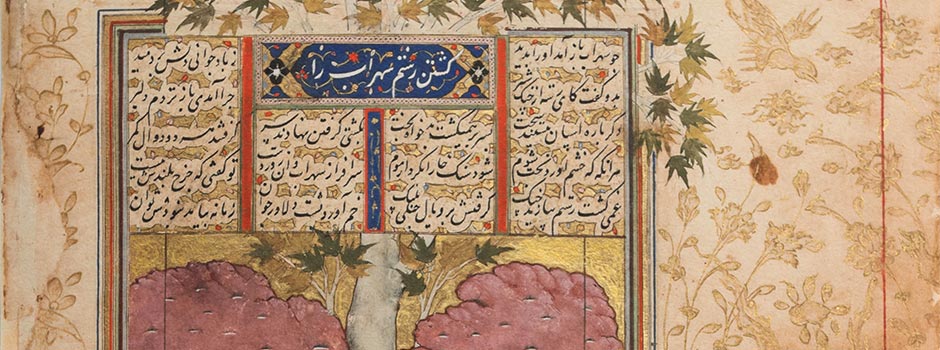
Lawrie Shabibi at The Armory Show (7 - 11 March, 2018) A New Body of Work by Shahpour Pouyan
Mar 07, 2018 Exhibition

In this presentation Shahpour Pouyan extends his enquiry into the genealogy of power, here in relation to ownership and the elimination of the human body, and the relation between a body of intellectuals/ intellectual property and centralized power/ the sovereign. He traces the political anatomy of power in Iran to its roots in ancient civilization, from old Persian myths through to the medieval period, and asks if the political tactic of punishing the body and soul of the thinker could also eliminate his intellectual property.
The massive wooden sculpture Incarnation of the Body Politic is shown together with related new works from his delicate two-dimensional Miniatures series. His Miniatures employ means both digital and manual to eradicate the figures and anachronistic details from illustrated historical manuscripts, whilst the sculpture brings the series full circle, making the imaginary something physical.
 Shahpour Pouyan, After, Ilkhanid Mongols Besieging a City, 2018, Mixed Media on Hahnemühle cotton paper, 38.43 x 28.9 cm (15 1/8 x 11 3/8 in) / Photography by Musthafa Aboobacker / Courtesy Lawrie Shabibi and the artist
Shahpour Pouyan, After, Ilkhanid Mongols Besieging a City, 2018, Mixed Media on Hahnemühle cotton paper, 38.43 x 28.9 cm (15 1/8 x 11 3/8 in) / Photography by Musthafa Aboobacker / Courtesy Lawrie Shabibi and the artist
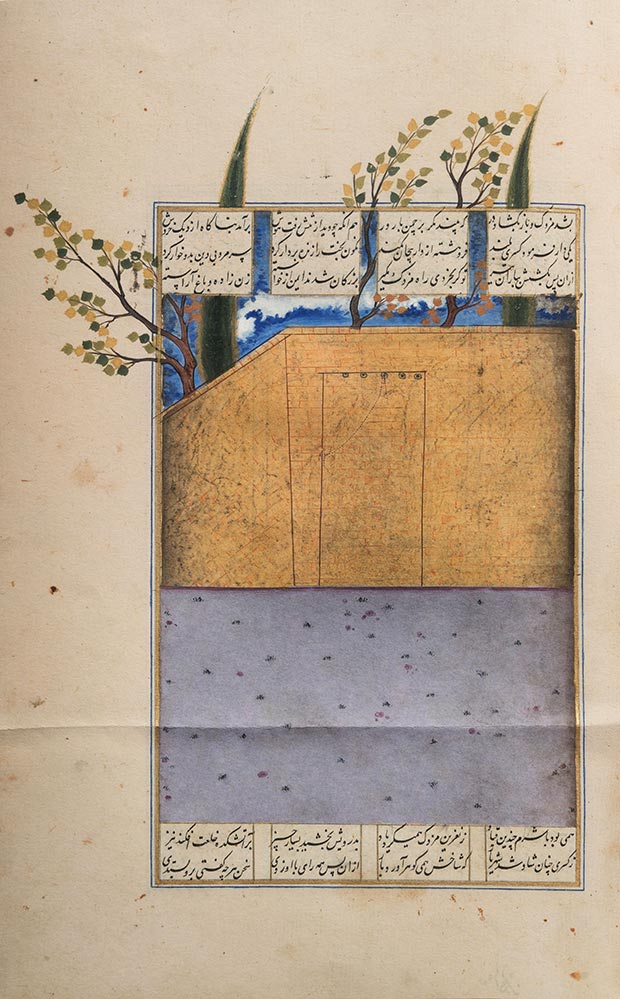 Shahpour Pouyan, After, the execution of Mazdak before Nushirwan, the arch-heretic and communist has been hoisted on a gallows by his feet and is being shot full of arrows, 2018, Mixed Media on Hahnemühle cotton paper, 33.19 x 19.96 cm (13 1/8 x 7 7/8 in) / Photography by Musthafa Aboobacker / Courtesy Lawrie Shabibi and the artist
Shahpour Pouyan, After, the execution of Mazdak before Nushirwan, the arch-heretic and communist has been hoisted on a gallows by his feet and is being shot full of arrows, 2018, Mixed Media on Hahnemühle cotton paper, 33.19 x 19.96 cm (13 1/8 x 7 7/8 in) / Photography by Musthafa Aboobacker / Courtesy Lawrie Shabibi and the artist
Pouyan’s sculpture is painted in the blackest black paint, over 4m long by 2m high, combines aspects of the guillotine (the revolutionary killing machine from the industrial age) and the trebuchet (a masterpiece of engineering from the medieval period). It is envisaged as a machine that filters and purifies the state, by treating the body as the political property of the state and as the place where the vengeance of the sovereign can be applied - the anchoring point of the manifestation of power. One component of this sculpture, the trebuchet, was a product of the Middle East - developed by Persian prisoners of the Mongols and used in their campaigns in Europe. The first recorded instance of biological warfare was at the siege of Kaffa in October 1347, when the Khanate of the Golden Horde employed such machines to hurl the plague victims into the city, using enslaved Persian engineers to operate it. Its other component, the guillotine, represents the more recent import of Western industrialization. Simplified, refined, and devoid of details such as ropes and metal parts, this sculpture is stripped of its obvious primary function. On the other hand, the addition of a plinth and pedestal suggests a secondary purpose for the apparatus, which having inflicted punishment, then uplifts its sacrificial victim to a status worthy of awe and emulation. Revolutionary thought and thinkers, thus disposed of, can then be reincorporated back into the body politic, as 'martyrs' or 'visionaries'. Pouyan states, “This sculpture is the missing part from the world of my Miniatures. It is a piece of machinery from the East that was lost in history. We do not know that much about its usage, who used it and against whom.â€
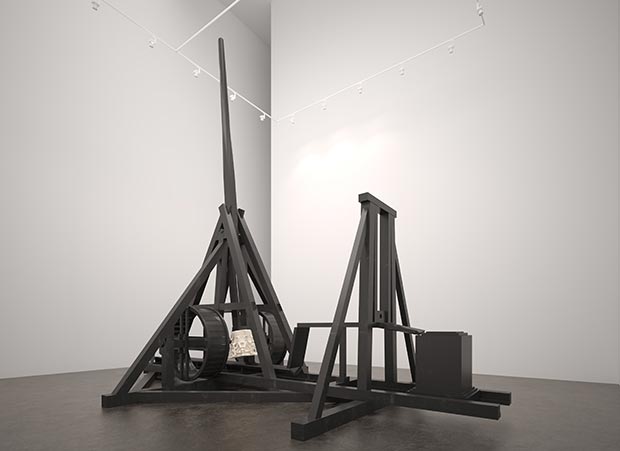 A rendering of The massive wooden sculpture Incarnation of the Body Politic / Courtesy Lawrie Shabibi and the artist
A rendering of The massive wooden sculpture Incarnation of the Body Politic / Courtesy Lawrie Shabibi and the artist
In his Miniatures, Pouyan presents illustrations that have been reworked from celebrated Persian manuscripts, editing out any of the details that are mythological, anachronistic or have since vanished. In practice this means editing out the figures, using both digital and manual means. In concurrence with the sculpture, Pouyan has selected historical miniatures with subjects that include torture and executions of heroes, martyrs, and thinkers from Persian miniatures, and siege engines used in Mongol campaigns. In these images, we have the title of the image and the story that is written in Persian text or Arabic. Missing in Pouyan’s Miniatures are the figures of heroes, executioners and observers, all of whom have been left out. Certain aspects – towers made of skulls, trebuchets, pits of sharpened spears – all take on a very different appearance and meaning without their human protagonists – in many ways mimicking the failure of Incarnation of the Body Politic as a functional object. Missing figures in these Miniatures included Mazdak, the first proto-socialist who was impaled by the Persian Sassanian king and Mansour Hallaj, the famous Sufi and spiritual leader in medieval Persia.
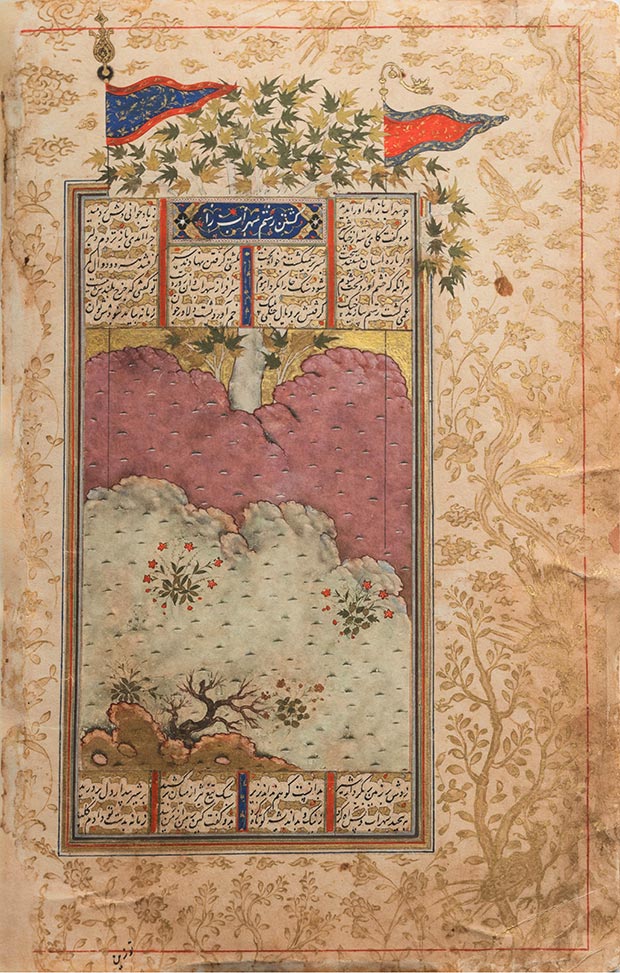 Shahpour Pouyan, After, Rustam slays his son, Suhrab, 2018, Mixed Media on Hahnemühle cotton paper, 32.4 x 20.8 cm (12 3/4 x 8 1/4 in) / Photography by Musthafa Aboobacker / Courtesy Lawrie Shabibi and the artist
Shahpour Pouyan, After, Rustam slays his son, Suhrab, 2018, Mixed Media on Hahnemühle cotton paper, 32.4 x 20.8 cm (12 3/4 x 8 1/4 in) / Photography by Musthafa Aboobacker / Courtesy Lawrie Shabibi and the artist
 Shahpour Pouyan, After, Captives thrown over a precipice after Timur's capture of a fortress in Sistan; a tower of severed heads behind, 2018, Mixed Media on Hahnemühle cotton paper, 24.89 x 17.64 cm, (9 3/4 x 7 in) / Photography by Musthafa Aboobacker / Courtesy Lawrie Shabibi and the artist
Shahpour Pouyan, After, Captives thrown over a precipice after Timur's capture of a fortress in Sistan; a tower of severed heads behind, 2018, Mixed Media on Hahnemühle cotton paper, 24.89 x 17.64 cm, (9 3/4 x 7 in) / Photography by Musthafa Aboobacker / Courtesy Lawrie Shabibi and the artist
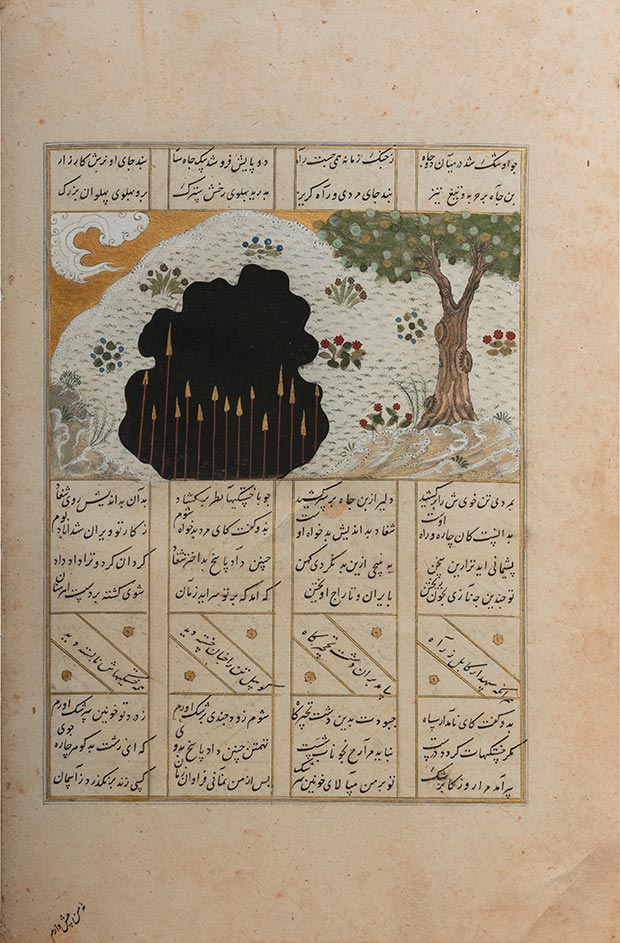 Shahpour Pouyan, After, Rustam, the great epic hero of the Iran, was lured by his treacherous half-brother to ride over a hidden pit implanted with spears, which impaled him and his trusted horse Raksh, 2018, Mixed Media on Hahnemühle cotton paper, 31.99 x 21.08 cm (12 5/8 x 8 1/4 in) / Photography by Musthafa Aboobacker / Courtesy Lawrie Shabibi and the artist
Shahpour Pouyan, After, Rustam, the great epic hero of the Iran, was lured by his treacherous half-brother to ride over a hidden pit implanted with spears, which impaled him and his trusted horse Raksh, 2018, Mixed Media on Hahnemühle cotton paper, 31.99 x 21.08 cm (12 5/8 x 8 1/4 in) / Photography by Musthafa Aboobacker / Courtesy Lawrie Shabibi and the artist
Other works from Pouyan’s Miniatures series are in the collections of the Metropolitan Museum, New York, the British Museum, the Grey Art Gallery, New York and the Johnson Museum of Art at Cornell University.
 Shahpour Pouyan, After, Soldiers filing before Timur, holding heads of their decapitated enemies which they used to build the tower of skulls at Baghdad, 2018, Mixed Media on Hahnemühle cotton paper, 31.55 x 20.15 cm (12 3/8 x 7 7/8 in) / Photography by Musthafa Aboobacker / Courtesy Lawrie Shabibi and the artist
Shahpour Pouyan, After, Soldiers filing before Timur, holding heads of their decapitated enemies which they used to build the tower of skulls at Baghdad, 2018, Mixed Media on Hahnemühle cotton paper, 31.55 x 20.15 cm (12 3/8 x 7 7/8 in) / Photography by Musthafa Aboobacker / Courtesy Lawrie Shabibi and the artist
Born in Isfahan, Iran, in 1979 Pouyan has an MFA in Integrated Practices and New Forms at Pratt Institute, New York, and an MFA in Painting from the Tehran University of Art.
Pouyan has had numerous solo gallery shows including: My Place is the Placeless, Lawrie Shabibi, Dubai, 2017; We Owe This Considerable Land to the Horizon Line, Galerie Nathalie Obadia, Paris, 2017; History Travels at Different Speeds, Copperfield, London, 2015; PTSD, Lawrie Shabibi, Dubai, 2014; Full Metal Jacket, Lawrie Shabibi, Dubai, 2011; The Hooves, Sixty Six Art Gallery, Tehran, 2010; Bana Bar In, Nar Gallery, Tehran, 2009; XVA Gallery Bastakia, Dubai, 2009 and Towers, Ave Gallery, Tehran, 2008.
Pouyan’s select institutional and museum exhibitions include the British Museum, London; the Aga Khan Museum, Toronto; the Museum of Fine Art, Houston; Asia Culture Centre, Gwangju, South Korea; Yinchuan Museum of Contemporary Art, China; Pera Museum, Istanbul; Grey Art Gallery, New York; and The Elgiz Museum, Istanbul. He has participated in the 7th Beijing Biennale National Art Museum of China, Beijing, China, 2017; Yinchuan Biennial, China, 2016; Kochi-Muziris Biennale, Kochi Island, India, 2014 and Mykonos Biennale, 2013. He will exhibit new works from his Miniatures series at the Lahore Biennial in March 2018.
His work is part of many prominent private and public collections including the Collection of Robert Littman and Sully Bonnelly, New York, USA; The Abby Weed Grey Collection of Modern Asian and Middle Eastern Art, New York; The British Museum, London; The Metropolitan Museum of Art, New York; Mohammed Afkhami Collection, Dubai; Huma Kabakci Collection, Istanbul; SYZYGY, New York; The Farjam collection, Dubai; Zoroastrian Cultural Institute, Paris and the Tehran Museum of Contemporary Art, Tehran.
In 2016, Pouyan was shortlisted for the Jameel Prize 4 by the Victoria and Albert Museum, London, UK and has been awarded the Civitella Ranieri Fellowship for Visual Arts in Umbria, Italy. He has participated in several international residencies including International Cite Des Arts, Paris, the Pegasus Art Foundation, Hyderabad, India, and the Elizabeth Foundation for the Arts, New York in March 2014.
Comments
Add a comment